Deck 17: Becoming a Modern Society: America in the Gilded Age, 1877-1900
Question
Question
Question
Question
Question
Question
Question
Question
Question
Question
Question
Question
Question
Question
Question
Question
Question
Question
Question
Question
Question
Question
Question
Question
Question
Question
Question
Question
Question
Question
Question
Question
Question
Question
Question
Question
Question
Question
Question
Question
Question
Question
Question
Question
Question
Question
Question
Question
Question
Question

Unlock Deck
Sign up to unlock the cards in this deck!
Unlock Deck
Unlock Deck
1/50
Play
Full screen (f)
Deck 17: Becoming a Modern Society: America in the Gilded Age, 1877-1900
1
The Great Migration that took place between 1890 and 1970 involved .
A) immigrants coming from Southern and Eastern Europe
B) African Americans moving from the South to the North
C) rural farmers moving to the cities
D) immigrants coming from Latin America and the Caribbean
A) immigrants coming from Southern and Eastern Europe
B) African Americans moving from the South to the North
C) rural farmers moving to the cities
D) immigrants coming from Latin America and the Caribbean
African Americans moving from the South to the North
2
When a civic reformer described New York's Tammany Hall as bearing "the same relation to the penitentiary as the Sunday school does to church," he was mostly alluding to its .
A) nativist policies against immigrants
B) social services to the urban poor
C) political corruption and unethical ways of getting money
D) condemnation of the upper class
A) nativist policies against immigrants
B) social services to the urban poor
C) political corruption and unethical ways of getting money
D) condemnation of the upper class
political corruption and unethical ways of getting money
3
How did the overall growth of urban population lead to higher crime rates in cities?
A) Larger populations fostered greater anonymity that promoted crime.
B) Most immigrants who came to the United States after the 1880s were banished criminals.
C) High rents led to evictions, which made committing crimes easier.
D) People moving to suburbs rather than the inner city were more prone to commit crimes.
A) Larger populations fostered greater anonymity that promoted crime.
B) Most immigrants who came to the United States after the 1880s were banished criminals.
C) High rents led to evictions, which made committing crimes easier.
D) People moving to suburbs rather than the inner city were more prone to commit crimes.
Larger populations fostered greater anonymity that promoted crime.
4

What was the primary purpose for requiring all students in American schools to recite the Pledge of Allegiance beginning in the 1890s?
A) It honored Columbus on the 400th anniversary of his arrival to the New World.
B) It Americanized the immigrant masses who were coming to the United States at this time.
C) It was part of a campaign to boost public education enrollment.
D) It advanced religious values by making students realize this was "one nation, under God."

Unlock Deck
Unlock for access to all 50 flashcards in this deck.
Unlock Deck
k this deck
5
The American Protective Association (APA) was established in 1887 as a response to the supposed dangers brought to the United States by immigrants.
A) Jewish
B) Northern European
C) Chinese
D) Catholic
A) Jewish
B) Northern European
C) Chinese
D) Catholic

Unlock Deck
Unlock for access to all 50 flashcards in this deck.
Unlock Deck
k this deck
6
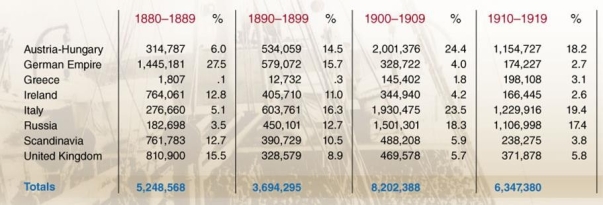
After 1880, immigrants from which of the following regions began to dominate the numbers of those coming to the United States?
A) Southern and Eastern Europe
B) the British Isles
C) the Caribbean and Latin America
D) Scandinavia

Unlock Deck
Unlock for access to all 50 flashcards in this deck.
Unlock Deck
k this deck
7
What was the major impact of improved water quality, waste removal, and street cleaning in urban centers during the late 1800s?
A) the creation of urban parks to offer wholesomeness and recreational spaces for city dwellers
B) the assurance of better safety measures to protect urbanites from rising crime rates
C) the alleviation of contagious diseases among the urban poor
D) the promotion of greater entrepreneurship for street vendors in ethnic enclaves
A) the creation of urban parks to offer wholesomeness and recreational spaces for city dwellers
B) the assurance of better safety measures to protect urbanites from rising crime rates
C) the alleviation of contagious diseases among the urban poor
D) the promotion of greater entrepreneurship for street vendors in ethnic enclaves

Unlock Deck
Unlock for access to all 50 flashcards in this deck.
Unlock Deck
k this deck
8
The primary goal of the Immigration Restriction League made up of Harvard graduates was to promote passage of a bill requiring immigrants to .
A) pass a literacy test
B) learn the Pledge of Allegiance
C) pay an entrance fee when coming to the United States
D) receive a series of inoculations against contagious diseases
A) pass a literacy test
B) learn the Pledge of Allegiance
C) pay an entrance fee when coming to the United States
D) receive a series of inoculations against contagious diseases

Unlock Deck
Unlock for access to all 50 flashcards in this deck.
Unlock Deck
k this deck
9
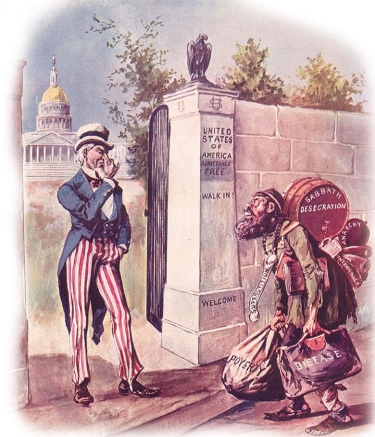
How was this 1899 image reflective of the nativist attitudes that many Americans had at this time?
A) The gateway contains welcoming messages for immigrants.
B) Uncle Sam is greeting the immigrant with scorn and disdain.
C) The immigrant carries habits and ideas that were valued by Americans.
D) The immigrant represents the foreigners willing to assimilate into American society.

Unlock Deck
Unlock for access to all 50 flashcards in this deck.
Unlock Deck
k this deck
10
How did the Brooklyn Bridge, which symbolized the new urban and industrial era of the late 1800s, also mark the transition from an earlier era?
A) The bridge linked the largest and third-largest cities in the United States, symbolizing the connections between the East and the West.
B) Emily Warren Roebling's role as onsite supervisor reflected the independent woman, a role valued in earlier times.
C) The bridge itself was made of steel, an ancient construction material.
D) The towers were built with stone and were formed into gothic archways, a medieval design.
A) The bridge linked the largest and third-largest cities in the United States, symbolizing the connections between the East and the West.
B) Emily Warren Roebling's role as onsite supervisor reflected the independent woman, a role valued in earlier times.
C) The bridge itself was made of steel, an ancient construction material.
D) The towers were built with stone and were formed into gothic archways, a medieval design.

Unlock Deck
Unlock for access to all 50 flashcards in this deck.
Unlock Deck
k this deck
11
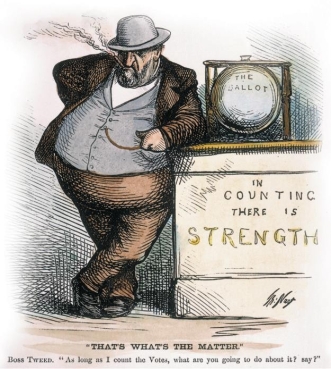
Why was the ballot box next to Boss William Tweed of Tammany Hall depicted as a glass ball?
A) Political machines intimidated voters by letting them know they were watching to see who they supported.
B) Political machines wanted to assure the public that the political and humanitarian work they did was transparent so that everyone knew what was going on.
C) Political machines wanted to make the public aware that civic participation was more important than political corruption.
D) Political machines wanted to let the press know that they ran fair elections.

Unlock Deck
Unlock for access to all 50 flashcards in this deck.
Unlock Deck
k this deck
12
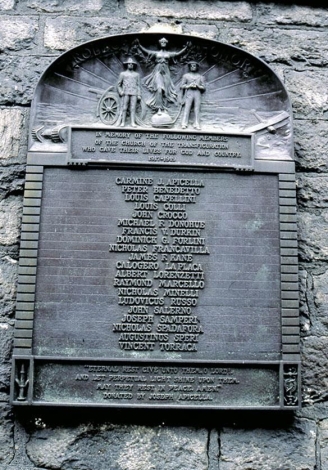
This World War I memorial honoring 17 Italian and 3 Irish soldiers at the Church of the Transfiguration in New York City, which originally was part of "Little Ireland" on the Lower East Side, captures the process of .
A) nativism
B) ethnic enclaves
C) ethnic succession
D) assimilation

Unlock Deck
Unlock for access to all 50 flashcards in this deck.
Unlock Deck
k this deck
13
How did Jacob Riis's How the Other Half Lives differ from other contemporary writings and traditional perspectives on urban poverty?
A) It portrayed the poor as happy with their circumstances.
B) It portrayed the poor as solely responsible for their fate.
C) It portrayed the poor as victims who dealt with factors beyond their control.
D) It portrayed the poor as corrupt and influenced by political machines.
A) It portrayed the poor as happy with their circumstances.
B) It portrayed the poor as solely responsible for their fate.
C) It portrayed the poor as victims who dealt with factors beyond their control.
D) It portrayed the poor as corrupt and influenced by political machines.

Unlock Deck
Unlock for access to all 50 flashcards in this deck.
Unlock Deck
k this deck
14
Most political machines in the late nineteenth century were associated with the .
A) Nativist Party
B) Republican Party
C) People's Party
D) Democratic Party
A) Nativist Party
B) Republican Party
C) People's Party
D) Democratic Party

Unlock Deck
Unlock for access to all 50 flashcards in this deck.
Unlock Deck
k this deck
15
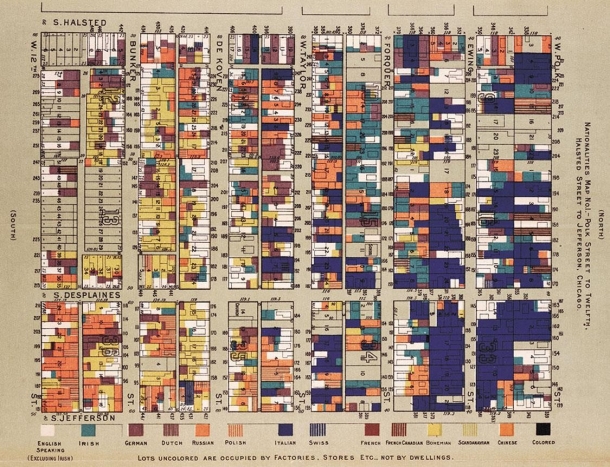
This map of the neighborhood around Chicago's Hull House reflects that .
A) Hull House was in a predominately white American neighborhood
B) this neighborhood was an ethnic enclave with a wide diversity of immigrants
C) African Americans from the South were migrating to Chicago in large numbers
D) the structures in this neighborhood were exclusively factories or stores

Unlock Deck
Unlock for access to all 50 flashcards in this deck.
Unlock Deck
k this deck
16
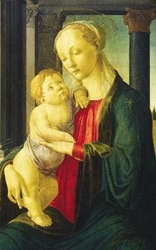
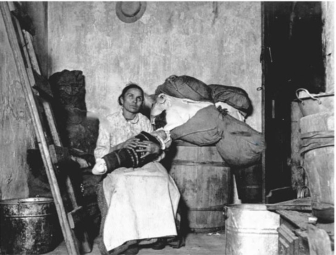
What was photographer Jacob Riis's intent in juxtaposing his photograph "In the Home of an Italian Ragpicker, Jersey Street" with Sandro Boticelli's Renaissance painting Madonna and Child?
A) He wanted to associate 1890s Italian immigrants with the values of the Italian Renaissance.
B) He wanted to focus on the Catholic beliefs of Italian immigrants.
C) He wanted to show that immigrants had the same maternal instincts as others.
D) He wanted to connect the plight of immigrants to religious imagery in order to gain sympathy for them.

Unlock Deck
Unlock for access to all 50 flashcards in this deck.
Unlock Deck
k this deck
17
Josiah Strong's comments that "The city has become a serious menace to our civilization…It has a peculiar attraction for the immigrant…here roughs, gamblers, thieves, robbers, lawless and desperate men of all sorts, congregate…" reflect nativist comments found in which of the following writings?
A) How the Other Half Lives: Studies among the Tenements of New York
B) the 1892 Platform of the People's Party
C) Our Country: Its Possible Future and Present Crisis
D) the text to "The Cross of Gold" speech
A) How the Other Half Lives: Studies among the Tenements of New York
B) the 1892 Platform of the People's Party
C) Our Country: Its Possible Future and Present Crisis
D) the text to "The Cross of Gold" speech

Unlock Deck
Unlock for access to all 50 flashcards in this deck.
Unlock Deck
k this deck
18
This photograph of a working-class neighborhood in New York contradicts which common notion about poverty?
A) that the poor lived isolated from other classes
B) that the neighborhoods of the poor were neglected
C) that it was solely caused by the moral failings of the poor
D) that those who had few skills were often poor
A) that the poor lived isolated from other classes
B) that the neighborhoods of the poor were neglected
C) that it was solely caused by the moral failings of the poor
D) that those who had few skills were often poor

Unlock Deck
Unlock for access to all 50 flashcards in this deck.
Unlock Deck
k this deck
19
Located in Chicago, what was the most well-known settlement house in the United States?
A) Hull House
B) Denison House
C) Henry Street Settlement
D) Toynbee Hall
A) Hull House
B) Denison House
C) Henry Street Settlement
D) Toynbee Hall

Unlock Deck
Unlock for access to all 50 flashcards in this deck.
Unlock Deck
k this deck
20
Most of the urban poor lived in multiple-family structures known as .
A) cottages
B) enclaves
C) settlement homes
D) tenements
A) cottages
B) enclaves
C) settlement homes
D) tenements

Unlock Deck
Unlock for access to all 50 flashcards in this deck.
Unlock Deck
k this deck
21
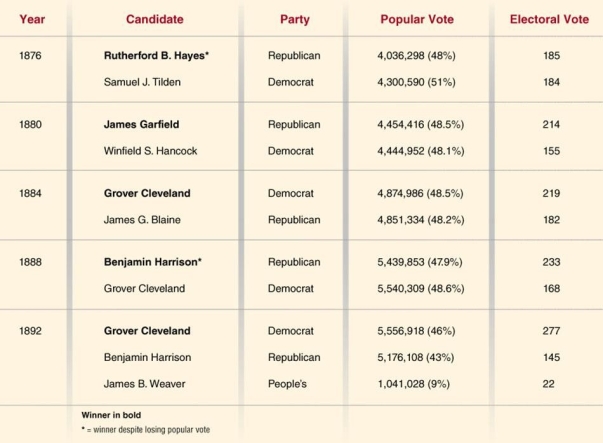
What conclusion can be made about the presidential elections during the Gilded Age?
A) The People's Party took over 25 percent of the popular vote in the 1892 election.
B) The electorate was evenly divided between Democrats and Republicans.
C) Every candidate who won the popular vote also won the electoral vote.
D) Incumbent presidents who ran for a second consecutive term were reelected to office.

Unlock Deck
Unlock for access to all 50 flashcards in this deck.
Unlock Deck
k this deck
22
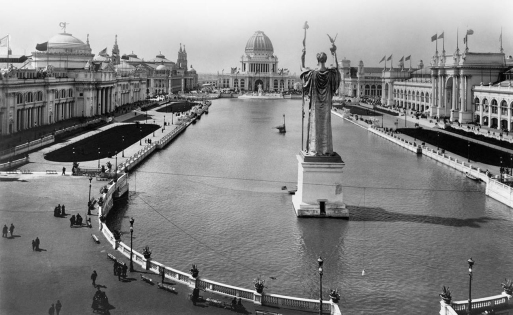
How did the 1893 Chicago World's Exposition, which was known as the White City, reflect a paradox that was typical of urban growth in the late nineteenth century?
A) The Beaux-Arts style of architecture contradicted the homage paid to the ancient world.
B) Urban planning transformed a swamp by Lake Michigan into a state-of-the-art site.
C) The grand vision of urban planning never fully caught on with other large cities.
D) This ornate location was occupied by displaced urban squatters during the Panic of 1893.

Unlock Deck
Unlock for access to all 50 flashcards in this deck.
Unlock Deck
k this deck
23
How did social reformers Jane Addams and Ellen Gates Starr differ from earlier socially conscious elite women in the United States?
A) They raised money for the poor.
B) They lobbied state legislatures for laws against child labor.
C) They chose to live among the poor in settlement houses.
D) They initiated the move to expand public education for immigrant children.
A) They raised money for the poor.
B) They lobbied state legislatures for laws against child labor.
C) They chose to live among the poor in settlement houses.
D) They initiated the move to expand public education for immigrant children.

Unlock Deck
Unlock for access to all 50 flashcards in this deck.
Unlock Deck
k this deck
24
What two factors in the late nineteenth century led directly to middle-class women having new, more public roles in American society?
A) bicycling and more liberating styles of clothing
B) greater roles in business and politics
C) lower birth rates and the right to vote
D) a rise in education and increased involvement in charitable and reformist clubs
A) bicycling and more liberating styles of clothing
B) greater roles in business and politics
C) lower birth rates and the right to vote
D) a rise in education and increased involvement in charitable and reformist clubs

Unlock Deck
Unlock for access to all 50 flashcards in this deck.
Unlock Deck
k this deck
25
What did Susan B. Anthony mean when she said "I stand and rejoice every time I see a woman ride by on a wheel"?
A) Bicycling gave women more freedom and self-reliance than before.
B) Driving automobiles gave women greater opportunities for self-improvement.
C) Mechanized farming gave women economic opportunities they did not have before.
D) Roller skating was a popular and liberating fad for women in the 1890s.
A) Bicycling gave women more freedom and self-reliance than before.
B) Driving automobiles gave women greater opportunities for self-improvement.
C) Mechanized farming gave women economic opportunities they did not have before.
D) Roller skating was a popular and liberating fad for women in the 1890s.

Unlock Deck
Unlock for access to all 50 flashcards in this deck.
Unlock Deck
k this deck
26
What was one positive result of the eight-hour day that labor demanded from employers?
A) a conversion to the "free silver" standard
B) greater acceptance of unions
C) increased leisure time for workers
D) greater wage increases for women in low-skilled jobs
A) a conversion to the "free silver" standard
B) greater acceptance of unions
C) increased leisure time for workers
D) greater wage increases for women in low-skilled jobs

Unlock Deck
Unlock for access to all 50 flashcards in this deck.
Unlock Deck
k this deck
27
The Pendleton Act of 1883 .
A) defined the political affiliations required of civil servants
B) opened government jobs to those who passed an exam
C) reserved a set of government jobs to campaign contributors
D) established the precedence for the Sherman Anti-Trust Act
A) defined the political affiliations required of civil servants
B) opened government jobs to those who passed an exam
C) reserved a set of government jobs to campaign contributors
D) established the precedence for the Sherman Anti-Trust Act

Unlock Deck
Unlock for access to all 50 flashcards in this deck.
Unlock Deck
k this deck
28
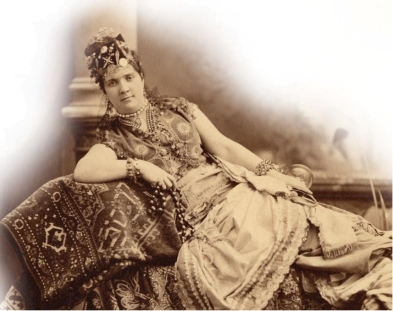
The ostentatious costumes worn by guests, such as the one in the picture above, to Mrs. Alva Vanderbilt's 1883 extravagant ball reveals what sociologist Thorstein Veblen referred to as
A) "gilded wealth"
B) the gold standard
C) "conspicuous consumption"
D) the "New Woman"

Unlock Deck
Unlock for access to all 50 flashcards in this deck.
Unlock Deck
k this deck
29
What was the real estate columnist in the Chicago Tribune advocating for in 1888 when he stated "Since water hems in the business center on three sides and the nexus of railroads on the south, Chicago must grow upward"?
A) settlement houses
B) skyscrapers
C) tenements
D) the White City
A) settlement houses
B) skyscrapers
C) tenements
D) the White City

Unlock Deck
Unlock for access to all 50 flashcards in this deck.
Unlock Deck
k this deck
30
Why did proponents of "soft money" advocate issuance of paper "greenbacks" and expanded coinage of silver?
A) "Soft money" in circulation promoted inflation that would raise farm prices and reduce debt.
B) "Soft money" would lower interest rates.
C) Silver was more plentiful and valuable than gold.
D) "Soft money" would lead to huge subsidies paid by consumers to business.
A) "Soft money" in circulation promoted inflation that would raise farm prices and reduce debt.
B) "Soft money" would lower interest rates.
C) Silver was more plentiful and valuable than gold.
D) "Soft money" would lead to huge subsidies paid by consumers to business.

Unlock Deck
Unlock for access to all 50 flashcards in this deck.
Unlock Deck
k this deck
31
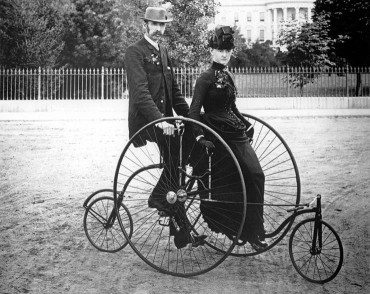
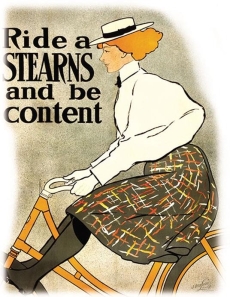
When combined together, what message do the 1886 photograph of the husband and wife cycling and the 1896 Stearns Bicycle Company advertisement poster imply about the status of middle-class American women during this ten-year period?
A) Even in leisure activities, American women still played subservient roles to their husbands.
B) Leisure activities like bicycling still required women to dress conservatively.
C) The bicycling enthusiasm of the 1890s led to growing independence for young women.
D) Bicycling was considered to be an unladylike activity.

Unlock Deck
Unlock for access to all 50 flashcards in this deck.
Unlock Deck
k this deck
32
What form of entertainment, characterized by low admission fees and a democratic approach, was geared for the masses in the late nineteenth century?
A) vaudeville
B) European operas
C) musical comedies
D) Old World theater productions
A) vaudeville
B) European operas
C) musical comedies
D) Old World theater productions

Unlock Deck
Unlock for access to all 50 flashcards in this deck.
Unlock Deck
k this deck
33
The City Beautiful Movement was comprised of .
A) reformers working to ameliorate the lives of the urban poor
B) architects and urban planners hoping to improve urban life through design
C) state and federal leaders trying to put an end to urban corruption
D) activists fighting to improve cleanliness and sanitation in working-class neighborhoods
A) reformers working to ameliorate the lives of the urban poor
B) architects and urban planners hoping to improve urban life through design
C) state and federal leaders trying to put an end to urban corruption
D) activists fighting to improve cleanliness and sanitation in working-class neighborhoods

Unlock Deck
Unlock for access to all 50 flashcards in this deck.
Unlock Deck
k this deck
34
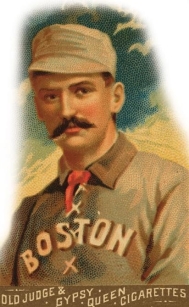
Why did cigarette companies in the 1880s decide to start issuing baseball cards featuring high-paid celebrities like Mike "King" Kelly to endorse their products?
A) Kelly's scandalous off-field behavior including his alcoholism made him a public favorite.
B) Kelly's athleticism and refined bearing made him the ideal man to legitimize tobacco use.
C) Kelly thought this type of advertisement would launch his baseball career.
D) Kelly's portrayal on baseball cards would offset ministers' anger for playing on Sundays.

Unlock Deck
Unlock for access to all 50 flashcards in this deck.
Unlock Deck
k this deck
35
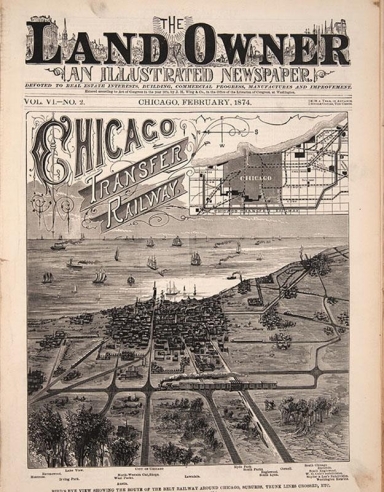
According to this 1874 cover of a Chicago real estate publication, what made the growth of suburbs near this metropolis possible?
A) established tracks for trains and trolleys
B) access to the city from Lake Michigan
C) a subway system
D) paved roads leading out of the city

Unlock Deck
Unlock for access to all 50 flashcards in this deck.
Unlock Deck
k this deck
36
The word gild in the term Gilded Age accurately describes the late nineteenth century in the United States because .
A) the majority of Americans benefited from the unprecedented growth in prosperity
B) it was characterized by the rise of large and remarkably beautiful cities
C) it was marked by the technological innovations achieved at all levels of society
D) its dazzling accomplishments were like a thin veneer when compared with its many social problems
A) the majority of Americans benefited from the unprecedented growth in prosperity
B) it was characterized by the rise of large and remarkably beautiful cities
C) it was marked by the technological innovations achieved at all levels of society
D) its dazzling accomplishments were like a thin veneer when compared with its many social problems

Unlock Deck
Unlock for access to all 50 flashcards in this deck.
Unlock Deck
k this deck
37
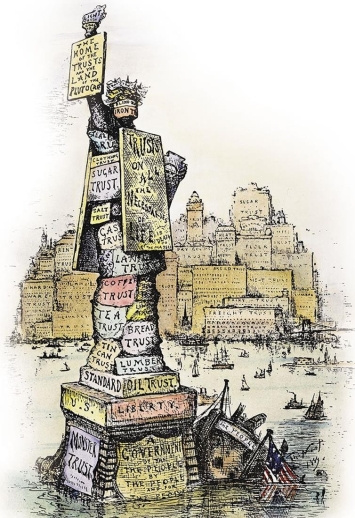
As illustrated in the 1889 cartoon The Rising of the Usurpers and the Sinking of the Liberties of the People, why did Thomas Nast believe that trusts were a threat to democracy and equality?
A) Pro-business legislators did little to slow the growth of big business.
B) Labor unions were weakened because strikes were seen as restraints of trade.
C) Corporate powers demanded long hours and dangerous work from industrial workers.
D) Wealthy executives used trusts to monopolize the necessities of life.

Unlock Deck
Unlock for access to all 50 flashcards in this deck.
Unlock Deck
k this deck
38
The "New Woman" of the 1890s best characterized middle-class American women who
)
A) married young
B) had over six children
C) wore conservative Victorian outfits
D) were college-educated
)
A) married young
B) had over six children
C) wore conservative Victorian outfits
D) were college-educated

Unlock Deck
Unlock for access to all 50 flashcards in this deck.
Unlock Deck
k this deck
39
What was the greatest cause of the new middle-class values, tastes, and social patterns that emerged during the late nineteenth century?
A) the City Beautiful Movement
B) reform movements to assist the urban poor
C) the creation of middle-class suburbs with like-minded people
D) the nativist movement
A) the City Beautiful Movement
B) reform movements to assist the urban poor
C) the creation of middle-class suburbs with like-minded people
D) the nativist movement

Unlock Deck
Unlock for access to all 50 flashcards in this deck.
Unlock Deck
k this deck
40
Who launched a national campaign against lynching in the 1890s that drew many African American women and men into public activism for civil rights?
A) Susan B. Anthony
B) Ida B. Wells
C) Jane Addams
D) Alva Vanderbilt
A) Susan B. Anthony
B) Ida B. Wells
C) Jane Addams
D) Alva Vanderbilt

Unlock Deck
Unlock for access to all 50 flashcards in this deck.
Unlock Deck
k this deck
41
As the leader of the American Railway Union, Eugene Debs led .
A) a march of unemployed men to Washington, D.C.
B) a strike against the Pullman Palace Car Company
C) the movement to create the People's Party
D) widespread protests against the gold standard
A) a march of unemployed men to Washington, D.C.
B) a strike against the Pullman Palace Car Company
C) the movement to create the People's Party
D) widespread protests against the gold standard

Unlock Deck
Unlock for access to all 50 flashcards in this deck.
Unlock Deck
k this deck
42
The National Alliance was formed from a coalition of .
A) women's suffrage activists
B) labor unions
C) progressive Democrats and Republicans
D) farmers' organizations
A) women's suffrage activists
B) labor unions
C) progressive Democrats and Republicans
D) farmers' organizations

Unlock Deck
Unlock for access to all 50 flashcards in this deck.
Unlock Deck
k this deck
43
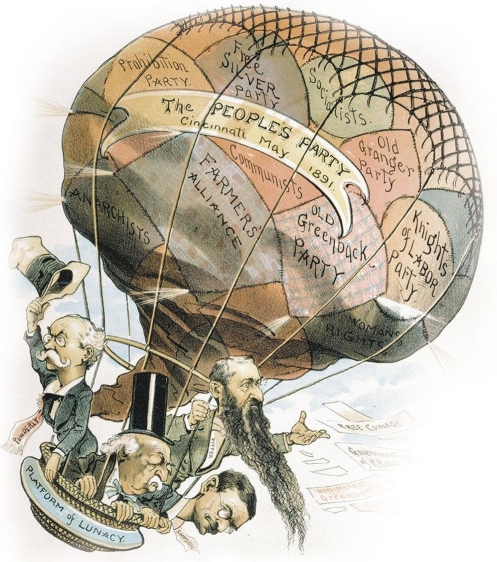
The cartoon "A Party of Patches" that appeared in the pro-Republican magazine Judge in 1891 was intended to .
A) support the Populist platform that called for an eight-hour day and free coinage of silver
B) recognize important labor leaders of the People's Party like Terrence Powderly
C) discredit the People's Party as a combination of strange and ideological movements
D) commemorate the first Populist Party convention in Cincinnati

Unlock Deck
Unlock for access to all 50 flashcards in this deck.
Unlock Deck
k this deck
44
What did the 1892 Platform of the People's Party reference when it mentioned that "a hireling army, unrecognized by our laws, is established to shoot [urban workmen] down"?
A) the shooting of Homestead strikers by armed members of the Pinkerton Detective Agency
B) the killing of 13 workers by federal troops during the Pullman strike
C) the arrest of Coxey's Army for "disturbing the peace" in Washington, D.C.
D) the use of police forces to break up strikers during the Haymarket Riot
A) the shooting of Homestead strikers by armed members of the Pinkerton Detective Agency
B) the killing of 13 workers by federal troops during the Pullman strike
C) the arrest of Coxey's Army for "disturbing the peace" in Washington, D.C.
D) the use of police forces to break up strikers during the Haymarket Riot

Unlock Deck
Unlock for access to all 50 flashcards in this deck.
Unlock Deck
k this deck
45
With the 1896 presidential election, the Republicans became the party representing
A) economic and international power
B) populism
C) Southern interests
D) government reform
A) economic and international power
B) populism
C) Southern interests
D) government reform

Unlock Deck
Unlock for access to all 50 flashcards in this deck.
Unlock Deck
k this deck
46
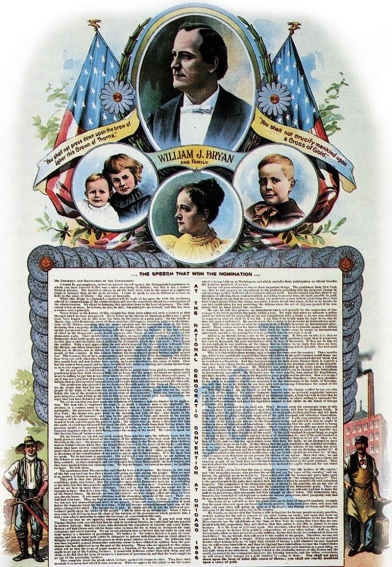
What message from William Jennings Bryan, the presidential candidate for both the Democrats and the Populist Party, did this campaign poster from the election of 1896 send to farmers and industrial workers?
A) He promised universal suffrage to all low-skilled and uneducated workers and farmers.
B) He advocated for railroad reform offering cheaper shipping rates and higher working wages.
C) He sought to improve race relations between whites and African Americans.
D) He wanted currency reform through the free coinage of silver rather than gold.

Unlock Deck
Unlock for access to all 50 flashcards in this deck.
Unlock Deck
k this deck
47
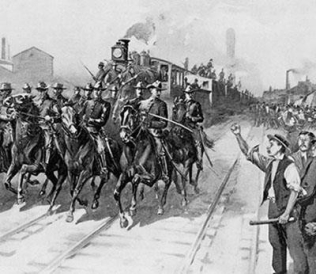
Who are the group of people on the right of this image and what type of emotion do they seem to be expressing as federal troops sent by President Cleveland escort the first meat train out of the Chicago stockyards at the end of the Pullman strike?
A) They are passengers who are angry that their train has been delayed due to the strike.
B) They are meat-packing and railroad entrepreneurs showing their gratitude to the troops.
C) They are strikers demonstrating blame and hostility toward the troops for breaking the strike.
D) They are strikebreakers thanking the troops and railroad executives for their new jobs.

Unlock Deck
Unlock for access to all 50 flashcards in this deck.
Unlock Deck
k this deck
48
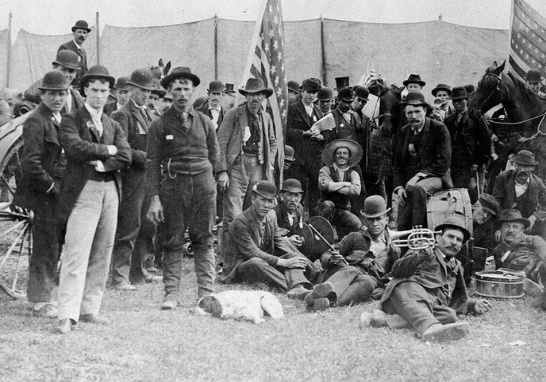
Why did Coxey's Army choose to pose as they did for this photograph in 1894 as they marched to Washington, D.C., to advocate for a public works project?
A) They wanted the public to know they were members of the middle class calling for reform.
B) They wanted to emphasize their patriotism and not appear to be violent radicals.
C) They wanted to intimidate law officials who threatened them with arrest and violence.
D) They wanted people to recognize them for their military service during the Civil War.

Unlock Deck
Unlock for access to all 50 flashcards in this deck.
Unlock Deck
k this deck
49
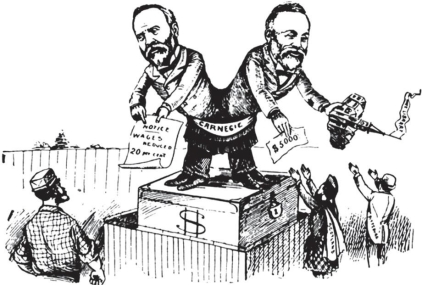
This cartoon published in the Utica, New York, Globe the week after the Homestead strike broke out at Andrew Carnegie's steel mills in the summer of 1892 depicted Carnegie as a(n)
A) hypocrite who cut his workers' wages in order to fund philanthropic projects
B) entrepreneur who was willing to negotiate with union leaders for better workers' rights
C) follower of "The Gospel of Wealth" who stated the rich should do good deeds with their money
D) proponent of new technology that included labor-saving machinery

Unlock Deck
Unlock for access to all 50 flashcards in this deck.
Unlock Deck
k this deck
50
What attitude toward the company town was expressed by the Pullman worker who said, "We are born in a Pullman house, fed from the Pullman shop, taught in the Pullman school, catechized in the Pullman church, and when we die we shall be buried in the Pullman cemetery and go to the Pullman Hell"?
A) bewilderment
B) celebration
C) gratitude
D) resentment
A) bewilderment
B) celebration
C) gratitude
D) resentment

Unlock Deck
Unlock for access to all 50 flashcards in this deck.
Unlock Deck
k this deck



